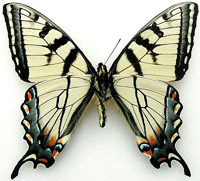Lepidoptera Survey, International

The Taxonomic Report of the International Lepidoptera Survey
Date of this Version
4-15-1999
Document Type
Article
Citation
Taxonomic Report of the International Lepidoptera Survey (April 15, 1999) 1(7): 1-4
Also available at https://lepsurvey.carolinanature.com/ttr/ttr-1-7.pdf
Abstract
Brephidium isophthalma pseudofea was described in 1873 from the Florida Keys, United States. The ventral ground color of the wings in topotypical pseudofea is a yellowish brown. The antennal clubs of pseudofea have prominent orange red tips. The ventral surface of the abdomen of pseudofea is broadly white to very light gray and usually extends halfway around the sides of the light to medium brown abdomen. Specimens of B. isophthalma from coastal South Carolina differ greatly from topotypical pseudofea. Accordingly, B. i. insularus is described as a new subspecies from coastal South Carolina. The antennal clubs of insularus are only slightly tipped in red, with many specimens having the antennae completely black. The light area on the ventral abdomen of insularus is medium to dark gray and does not extend up the dark brown sides of the abdomen, giving it a very dark appearance. The ventral surface of the wings of insularus are medium chocolate brown with prominent white markings. The spring brood of insularus is especially unique and was given the name carolina (Pavulaan, 1993). The northern and southern limits of insularus’ range is undetermined. However, we expect insularus to be the resident subspecies in at least South Carolina, Georgia, and northern Florida. Its common name is Island Pigmy Blue. It is possible that insularus is a distinct species. It is likely that pseudofea is conspecific with B. exilis.


Comments
Copyright 1999, International Lepidoptera Survey. Open access material
License: Creative Commons Attribution-ShareAlike-NonCommercial 4.0 International (CC BY-SA-NC 4.0 International)